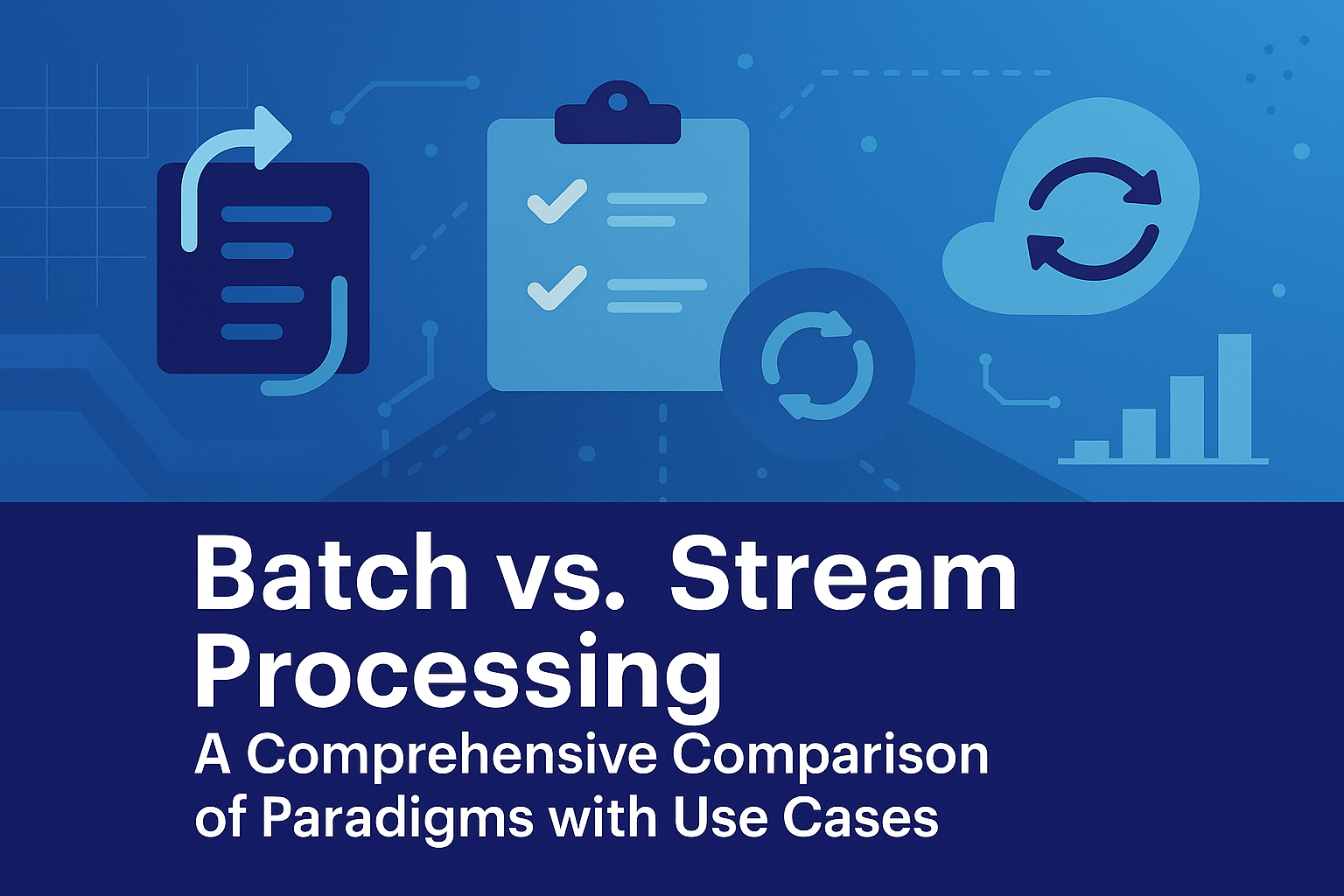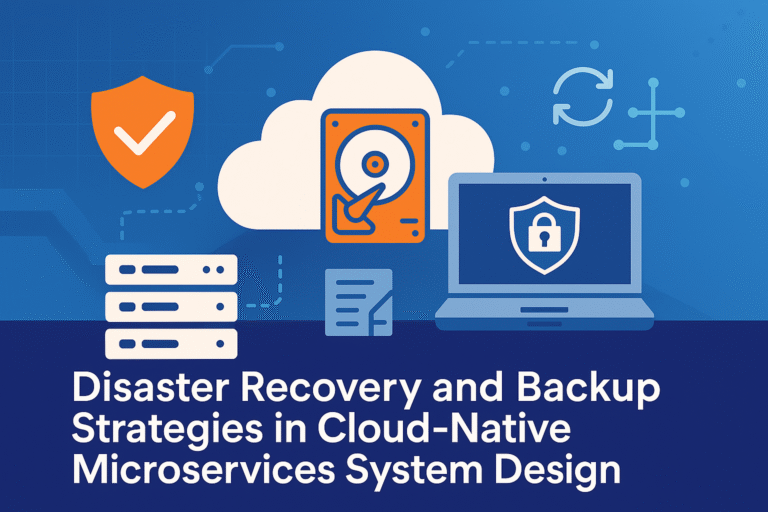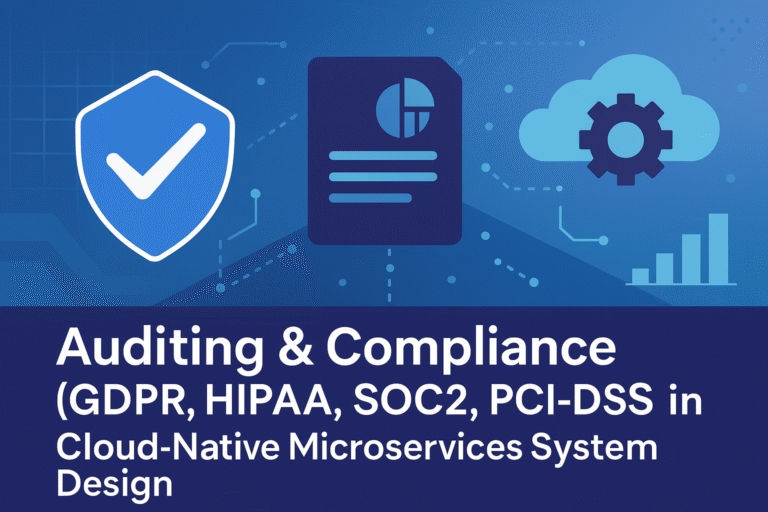Introduction
In distributed systems design, data processing paradigms play a pivotal role in determining how efficiently and effectively a system handles varying workloads. Two fundamental approaches are batch processing and stream processing. Batch processing involves collecting data into groups (batches) and processing them at scheduled intervals, which is suitable for scenarios where immediate results are not required. Stream processing, by contrast, handles data as a continuous flow, enabling real-time analysis and response. This analysis provides a detailed comparison of these paradigms, examining their mechanisms, applications, advantages, limitations, and trade-offs. It integrates prior concepts such as the CAP Theorem (balancing consistency and availability in data flows), consistency models (strong vs. eventual for processed data), consistent hashing (for load distribution in processors), idempotency (for safe retries in streaming), unique IDs (e.g., Snowflake for event tracking), heartbeats (for processor liveness), failure handling (e.g., retries in streams), single points of failure (SPOFs) avoidance (through replication), checksums (for data integrity in batches/streams), GeoHashing (for spatial data processing), rate limiting (to control stream ingress), Change Data Capture (CDC) (for feeding streams), load balancing (for processor nodes), quorum consensus (in stream coordination), multi-region deployments (for global processing), capacity planning (for resource estimation), and message queues (e.g., Kafka for streaming). The discussion offers strategic insights for system architects to select the appropriate paradigm based on workload characteristics, ensuring scalable, reliable, and low-latency systems.
Mechanisms of Batch and Stream Processing
Batch Processing Mechanism
Batch processing aggregates data into discrete groups and processes them in a single, scheduled operation. It is typically offline, triggered by time intervals (e.g., nightly jobs) or data thresholds (e.g., 1GB batches).
- Core Steps:
- Data Collection: Accumulate data from sources (e.g., logs, databases) into storage like S3 or HDFS.
- Processing: Execute transformations or computations on the entire batch using frameworks like Apache Spark or Hadoop MapReduce. This involves parallel tasks across nodes, often with consistent hashing for data distribution.
- Output: Store results in a sink (e.g., database or file system) for later use.
- Error Handling: Retries on batch failures, with idempotency ensuring repeated runs do not duplicate outputs (e.g., using unique IDs like Snowflake for batch identifiers).
- Mathematical Foundation:
- Throughput: Throughput=batch_sizeprocessing_time \text{Throughput} = \frac{\text{batch\_size}}{\text{processing\_time}} Throughput=processing_timebatch_size, e.g., 1TB batch processed in 1 hour = 278MB/s.
- Latency: Equal to batch interval + processing time (e.g., 1 hour interval + 30 minutes processing = 1.5 hours end-to-end).
- Resource Utilization: Peak usage during processing (e.g., 80% CPU for 30 minutes), idle otherwise.
- Fault Tolerance: Uses replication (e.g., 3x in HDFS) and heartbeats for node liveness; failures trigger job restarts from checkpoints.
Stream Processing Mechanism
Stream processing treats data as an unbounded, continuous flow, processing events in real time or near real time as they arrive.
- Core Steps:
- Data Ingestion: Consume events from sources like message queues (e.g., Kafka topics) using CDC for database changes.
- Processing: Apply transformations (e.g., filtering, aggregation) using frameworks like Apache Flink or Kafka Streams. Events are partitioned (e.g., via consistent hashing) for parallel processing across nodes.
- Output: Emit results to sinks (e.g., databases, caches) in real time.
- Error Handling: Idempotency for safe retries (e.g., using unique IDs), rate limiting (e.g., Token Bucket) to prevent overload, and dead-letter queues (DLQs) for failed events.
- Mathematical Foundation:
- Throughput: Throughput=N×node_throughput \text{Throughput} = N \times \text{node\_throughput} Throughput=N×node_throughput, where N N N is nodes (e.g., 10 nodes × 100,000 events/s = 1M events/s).
- Latency: Latency=ingress_time+processing_time+egress_time \text{Latency} = \text{ingress\_time} + \text{processing\_time} + \text{egress\_time} Latency=ingress_time+processing_time+egress_time, e.g., < 10ms end-to-end.
- Windowing: For aggregations, window size (e.g., 5 minutes) affects memory (e.g., 1GB for 1M events/window).
- Fault Tolerance: Uses replication and quorum consensus (e.g., in Flink checkpoints) for recovery; heartbeats detect failures (< 5s failover).
Comparison of Batch and Stream Processing
Structural Differences
- Data Model: Batch processes finite datasets (e.g., daily logs), stream handles unbounded flows (e.g., continuous clicks).
- Timing: Batch is periodic (e.g., hourly), stream is continuous (e.g., immediate).
- State Management: Batch is stateless per run, stream maintains state (e.g., running aggregates in Kafka Streams).
- Failure Recovery: Batch restarts from scratch or checkpoints, stream resumes from last offset (e.g., Kafka consumer groups).
Performance Comparison
| Aspect | Batch Processing | Stream Processing |
|---|---|---|
| Latency | High (minutes to hours) | Low (< 10ms to seconds) |
| Throughput | High for large batches (e.g., 1TB/hour) | High for continuous flows (e.g., 1M events/s) |
| Resource Usage | Peak during runs (e.g., 80% CPU for 1 hour) | Steady (e.g., 50–70% CPU continuously) |
| Scalability | Vertical (e.g., larger machines) or horizontal (e.g., Spark clusters) | Horizontal (e.g., add Kafka partitions/brokers) |
| Fault Tolerance | Checkpoints (e.g., Spark restart from last checkpoint) | Offsets and replication (e.g., Kafka resume from last offset) |
Advantages and Limitations
Batch Processing:
- Advantages:
- Efficiency for Large Volumes: Processes massive datasets cost-effectively (e.g., Spark on Hadoop for 1PB data at $0.01/GB/month).
- Simplicity: No need for continuous monitoring; scheduled jobs reduce operational complexity.
- Resource Optimization: Runs during off-peak hours, minimizing compute costs (e.g., 40% savings with spot instances).
- Strong Consistency: Easier to ensure in finite runs (e.g., ACID transactions in batch ETL).
- Limitations:
- High Latency: Delays insights (e.g., hours for daily reports).
- Inefficient for Real-Time: Unsuitable for immediate needs (e.g., fraud detection).
- Resource Spikes: Causes peak loads (e.g., 100% CPU during runs).
- Scalability Limits: Vertical scaling caps throughput (e.g., max 128 cores).
Stream Processing:
- Advantages:
- Real-Time Insights: Enables immediate actions (e.g., < 10ms for anomaly detection in Flink).
- Continuous Scalability: Handles unbounded data with horizontal scaling (e.g., add Kafka brokers for 2x throughput).
- Flexibility: Supports stateful operations (e.g., windowed aggregates in Kafka Streams).
- Fault Tolerance: Resumes from checkpoints (e.g., < 100ms lag in Kafka).
- Limitations:
- Higher Complexity: State management and windowing add overhead (e.g., 10–20% CPU for Flink).
- Resource Intensity: Continuous processing requires steady compute (e.g., $0.05/GB/month for always-on brokers).
- Eventual Consistency Risks: Lag (10–100ms) may cause temporary inaccuracies.
- Cost: Higher for persistent streams (e.g., 1TB/day storage).
Use Cases with Real-World Examples
Batch Processing Use Cases
- Financial Reporting in Banking:
- Context: A bank generates daily reports on 500,000 transactions, needing cost-effective processing without real-time requirements.
- Implementation: Data collected in S3 throughout the day (1GB batch), processed nightly with Apache Spark (distributed across 10 nodes with consistent hashing for load distribution). Outputs stored in a data warehouse like Snowflake. Checksums (SHA-256) verify data integrity during transfer, and rate limiting controls S3 ingress.
- Performance: 1-hour processing time, < 0.01% error rate, $0.01/GB/month cost.
- Trade-Off: High latency (hours) balanced by low cost and simplicity.
- Log Analysis in a Logistics Firm:
- Context: Analyzing 1M shipment logs/day for efficiency insights, processed in batches to minimize costs.
- Implementation: Logs ingested to HDFS, processed with Hadoop MapReduce (sharded across 5 nodes). Outputs fed to a dashboard via CDC. Heartbeats monitor node health, and failure handling restarts jobs from checkpoints.
- Performance: 30-minute batch runs, 500,000 logs/s throughput, 99.99% uptime.
- Trade-Off: Delayed insights (daily) for scalable, low-cost analysis.
Stream Processing Use Cases
- Real-Time Fraud Detection in E-Commerce:
- Context: An online retailer processes 100,000 transactions/day, needing immediate fraud alerts to prevent losses.
- Implementation: Transactions streamed to a Kafka topic with 20 partitions (consistent hashing for distribution). Kafka Streams aggregates patterns (e.g., over 5-minute windows), using transactions for exactly-once semantics and idempotency to avoid duplicate alerts. Outputs trigger notifications via a pub/sub system. Multi-region replication ensures global availability (< 100ms lag), with rate limiting (Token Bucket) capping producer bursts.
- Performance: < 10ms end-to-end latency, 100,000 events/s, 99.999% uptime, < 0.1% false positives.
- Trade-Off: Higher operational complexity for real-time accuracy.
- Sensor Monitoring in Manufacturing:
- Context: A factory monitors 1M sensor readings/s from equipment, needing real-time anomaly detection to avoid downtime.
- Implementation: Sensors publish to a “sensor_data” topic with 50 partitions, replicated 3x. Flink processes streams for aggregations (e.g., temperature averages), integrating GeoHashing for location-based alerts and CDC from equipment databases. Heartbeats detect consumer failures (< 5s failover), and quorum consensus (KRaft) manages metadata.
- Performance: < 10ms latency, 1M readings/s, 99.999% uptime.
- Trade-Off: Continuous resource usage balanced by proactive maintenance savings.
Integration with Prior Concepts
- CAP Theorem: Batch aligns with CP for consistent processing; stream favors AP for availability during partitions.
- Consistency Models: Batch supports strong consistency (e.g., ACID in Spark); stream uses eventual consistency (e.g., Kafka transactions for exactly-once).
- Consistent Hashing: Distributes batch/stream data across nodes (e.g., Kafka partitions).
- Idempotency: Ensures safe stream retries (e.g., Kafka producers).
- Heartbeats: Monitors processors in stream systems (< 5s detection).
- Failure Handling: Retries for batch, DLQs for streams.
- SPOFs: Replication in both paradigms.
- Checksums: SHA-256 for data integrity in batch/stream.
- GeoHashing: Enhances stream processing for location data.
- Load Balancing: Least Connections for stream consumers.
- Rate Limiting: Token Bucket caps stream ingress.
- CDC: Feeds streams from databases.
- Multi-Region: Streams replicate across regions.
- Capacity Planning: Estimates compute for streams (e.g., 10 nodes for 1M/s).
Trade-Offs and Strategic Considerations
- Latency vs. Throughput:
- Batch: High throughput for large data (e.g., 1TB/hour) but high latency (minutes-hours).
- Stream: Low latency (< 10ms) but requires steady resources for continuous processing.
- Decision: Use batch for cost-effective analysis (e.g., nightly reports), stream for real-time (e.g., fraud detection).
- Interview Strategy: Justify batch for financial reporting, stream for e-commerce fraud.
- Cost vs. Timeliness:
- Batch: Lower cost (off-peak runs, spot instances) but delayed insights.
- Stream: Higher cost (always-on compute) but timely actions.
- Decision: Use batch for non-urgent tasks, stream for business-critical.
- Interview Strategy: Propose batch for logistics log analysis, stream for manufacturing monitoring.
- Complexity vs. Flexibility:
- Batch: Simpler (scheduled jobs) but inflexible (fixed intervals).
- Stream: Complex (state management, windowing) but flexible (real-time adaptations).
- Decision: Use batch for stable workloads, stream for dynamic.
- Interview Strategy: Highlight batch simplicity for small teams, stream flexibility for Uber.
- Fault Tolerance vs. Overhead:
- Batch: Checkpoints enable restarts but add overhead (10–20% time).
- Stream: Offsets and replication provide tolerance but increase storage (3x with replicas).
- Decision: Use stream for high-availability needs, batch for tolerant delays.
- Interview Strategy: Justify stream for banking fraud (low MTTR), batch for reports.
- Scalability vs. Consistency:
- Batch: Scales with cluster size but ensures strong consistency.
- Stream: Scales with partitions but risks eventual consistency lag (10–100ms).
- Decision: Use stream for high-scale, eventual-tolerant apps.
- Interview Strategy: Propose stream for 1M/s IoT, batch for consistent analysis.
Advanced Implementation Considerations
- Deployment: Use Kubernetes for batch (Spark) or stream (Flink/Kafka Streams) clusters with 10 nodes (16GB RAM).
- Configuration:
- Batch: Spark with 10 executors, checkpoints every 10 minutes.
- Stream: Kafka with 50 partitions, 3 replicas, transactions enabled.
- Performance Optimization:
- Use SSDs for < 1ms I/O in streams.
- Enable compression (GZIP) to reduce network by 50–70%.
- Cache states in Redis for < 0.5ms access in streams.
- Monitoring:
- Track throughput (1M events/s), latency (< 10ms), and lag (< 100ms) with Prometheus/Grafana.
- Monitor resource usage (> 80% triggers alerts) via CloudWatch.
- Security:
- Encrypt data with TLS 1.3.
- Use IAM/RBAC for access control.
- Verify integrity with SHA-256 checksums (< 1ms overhead).
- Testing:
- Stress-test with JMeter for 1M events/s.
- Validate fault tolerance with Chaos Monkey (e.g., fail 2 nodes).
- Test lag and recovery scenarios.
Discussing in System Design Interviews
- Clarify Requirements:
- Ask: “What’s the data volume (1TB/day)? Latency needs (< 10ms)? Real-time or periodic processing?”
- Example: Confirm real-time fraud detection for banking with < 10ms latency.
- Propose Paradigm:
- Batch: “Use for daily financial reports with Spark.”
- Stream: “Use for real-time fraud with Kafka Streams.”
- Example: “For e-commerce, implement stream for fraud, batch for reporting.”
- Address Trade-Offs:
- Explain: “Batch is cost-effective but delayed; stream is real-time but resource-intensive.”
- Example: “Use batch for logistics analysis, stream for manufacturing monitoring.”
- Optimize and Monitor:
- Propose: “Use partitioning for stream throughput, monitor lag with Prometheus.”
- Example: “Track banking fraud latency for optimization.”
- Handle Edge Cases:
- Discuss: “Mitigate stream lag with more partitions, handle batch failures with checkpoints.”
- Example: “For manufacturing, use DLQs for failed sensor events.”
- Iterate Based on Feedback:
- Adapt: “If real-time is critical, shift to stream; if cost is key, use batch.”
- Example: “For retail, add stream processing if analytics need real-time insights.”
Conclusion
Batch and stream processing are complementary paradigms in distributed systems, with batch excelling in efficient, periodic handling of large datasets (e.g., financial reporting) and stream providing real-time insights for continuous flows (e.g., fraud detection). Batch offers cost savings and simplicity but high latency, while stream delivers low latency and flexibility but higher complexity and resource demands. Integration with concepts like CDC, replication, and rate limiting enhances their effectiveness, while trade-offs like latency vs. throughput guide selection. Real-world examples from banking and manufacturing illustrate how these paradigms enable scalable, resilient systems. By aligning with workload requirements and monitoring key metrics, architects can design optimized data processing solutions for modern applications.




